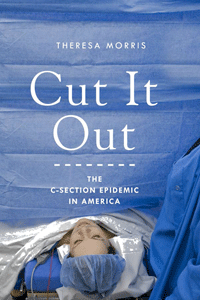Cut It Out: The C-Section Epidemic in America- A Book Review
Ever wondered why the c-section rate is so high and just seems to keep growing? Ever wonder what, if anything, we can actually DO about it as citizens, women, mothers, and voters?
Sometimes I literally feel like I live and breathe birth. I write about it. I read about it. I teach about birth. I train teachers to teach birth. My paid work even revolves around childbirth. With all of that and all that I see others doing, we do see good things happening on an individual basis. But we continue to see a ridiculously high c-section rate and so many women convinced they needed a surgery when the data clearly shows we are doing too many c-sections.
Enter Theresa Morris and her recently published book, Cut It Out: The C-Section Epidemic in America. Morris is a sociologist whose academic background, and her own cesarean and subsequent VBAC, seem to have inspired this fabulously important book.
While separating the reality from the assumed, Morris delves into the institutional constraints that drive cesarean. From insurance companies to peer review to an oppressive fear of litigation that physicians face, her approach is systematic, unemotional, and exactly what is needed to more fully understand the crisis in obstetrics.
As I listen to women's fears as they prepare for birth, many want to avoid a cesarean. They are afraid of doctors in general. They have heard of these men who schedule cesareans around their golf games and ski vacations. While surely such men exist, the cesarean section rate hovering over 30% signifies a problem much bigger than golf games.
When I talk to women after their cesarean, many are fine with their surgery. They were told by their trusted physician that the surgical delivery was necessary. They were there. They know the explanation. They feared for the safety of their child and so did their doctor.
Morris dispels the myth of a rate driven by jerk doctors as well as the myth that every cesarean is necessary. Instead, she describes a reality much more complex. Weighed down by excessive insurance premiums, constant fear of litigation, and a hospital culture that encourages (possibly without meaning to) cesarean, doctors are often only players in a brutal game much bigger than their own desires. While women often are told they needed a cesarean, their physicians motivations may be very different than we realize. Fear and liability, not golf games are driving factors in cesarean rates. Doctors and women are making the best choices they can within a system that desperately needs improvement.
I love what Dr Morris has done in deconstructing this problem, in an unbiased and academic manner. I love to see people from different disciplines approach childbirth in America and look at it with their own lens. When we read the works of people like anthropologist, Robbie Davis-Floyd, journalists Dr Jennifer Margulis and Jennifer Block, and a sociologist like Theresa Morris, we gain a bigger picture and greater understanding of what is really happening with birth.
Perhaps most important of all is that Theresa Morris provides lists of things we can actually DO to lower the cesarean section rate. Did I cheer when the first thing she mentioned was recommend that women take an independent childbirth class? Maybe, just a little...
Morris' solutions were more than just for women but for their providers, for insurance companies and policy makers. Cut It Out: The C-Section Epidemic in America, is an important book and one I would strongly encourage anyone who seeks change in childbirth to carefully read.

Comments